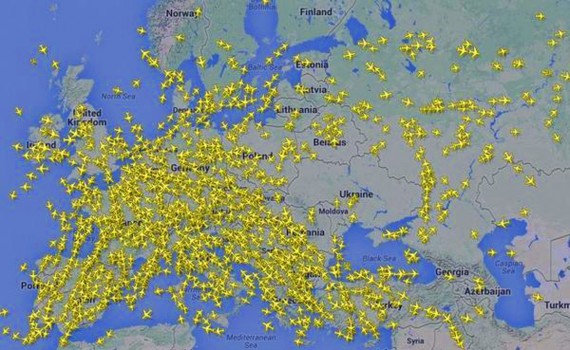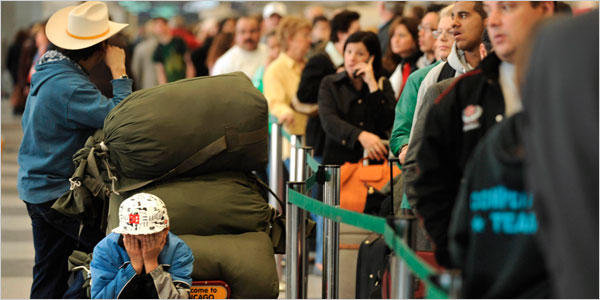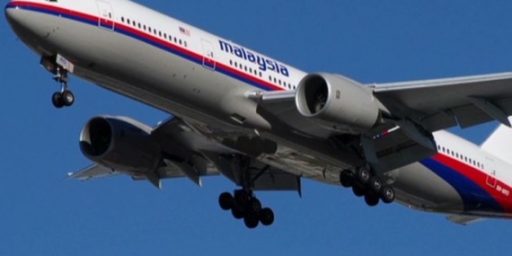Why Were Commercial Jets Flying Over Eastern Ukraine To Begin With?
Basically, the answer is that nobody really thought there was much of a risk that a plane could be shot down.
Yesterday’s tragic attack on Malaysia Airlines Flight 17 in the skies over eastern Ukraine has led many people to wonder why planes were flying over disputed territory to being with. After all, even though it’s apparently relatively easy to pick out on radar systems both due to their transponder signals and the fact that they are typically flying at altitudes that military planes do not, the possibility of a tragic accident, which is likely what this will turn out to have been in the end, remains. Additionally, both in the past several days and the past several weeks, there have been plenty of reports about planes being shot out of the sky by pro-Russian separatists and possibly others. Given that, it would seem to be prudent to have rerouted planes to avoid an area of potential danger. As it turns out, there have been some warnings issued regarding Ukrainian and Russian airspace over the past several months, but the area was still being heavily used by international carriers from many nations until yesterday morning:
In the hours after Thursday’s disaster involving a Malaysia Airlines jet, carriers around the globe began rerouting flights to avoid Ukraine. Some had been circumventing the country for weeks. Experts questioned the airline’s decision to fly near the fighting, even as Malaysia’s prime minister said that the plane’s route from Amsterdam to Kuala Lumpur was declared safe by international aviation authorities.
“I find it pretty remarkable that a civil airline company — if this aircraft was on the flight plan — that they are flight-planning over an area like that,” said Robert Francis, a former vice chairman of the National Transportation Safety Board.
Violence in Ukraine between government forces and pro-Russia rebels in the country’s east erupted a month after Russia annexed Ukraine’s Crimean Peninsula in March. Earlier this week, the rebels claimed responsibility for hitting a Ukrainian military jet with a portable surface-to-air missile; the pilot was able to land safely. And the government charged that a military transport plane was shot down by a missile fired from Russian territory.
In April, the U.S. Federal Aviation Administration cautioned airlines that Russia’s claim to the airspace over Ukraine’s Crimea could lead to conflicting air traffic control instructions. A few weeks later, the FAA issued a tougher warning, telling pilots not to fly over the area, and the U.N.’s International Civil Aviation Organization told governments to warn their airlines. Thursday’s crash, however, occurred outside the warning areas.
Thomas Routh, an aviation attorney in Chicago, said it would be unusual for an airline to ignore such warnings, but he said it’s up to airlines to decide whether a flight will be safe for crew and passengers.
“There are airlines flying through Afghanistan airspace every day,” Routh said.
John Cox, a former airline pilot and accident investigator, said despite the cautions, the airspace was not closed. The Malaysia Airlines crew filed a flight plan and “Russia and the Ukraine both accepted the airplane into their airspace,” he said.
Rerouting planes around war zones costs airlines money, as the planes burn more expensive jet fuel. Aviation expert Norman Shanks said many airlines continued to fly over Ukraine despite warnings because it offered a shorter route that saved money on fuel.
The other factor, of course, is that nobody really thought that there was much of a risk to commercial airliners traveling at 32,000 feet because there had been very little indication that any of the belligerents were making wide use of the types of weapons that could reach that far into the air. As noted above, the main reason that the FAA restricted American carriers from flying over the Crimean Peninsula was not because they might be in danger of being shot down, but because there’s a dispute over who’s actually in charge of air traffic control in the area. Other parts of the eastern Ukraine were, generally, open to international air travel although there had been some individual carriers who had made the voluntarily decision to reroute their planes out of an abundance of caution. As a general rule, though, the airspace in question has been a common and apparently heavily traveled route for planes flying from Europe to Asia for a very long time and there was no reason to think that the planes flying in the skies over the area were in no real danger notwithstanding the conflict on the ground. Indeed, as noted in the linked article, international air travel over the skies in Afghanistan has been commonplace notwithstanding the decade-long war in that country.
There are plenty examples, of course, of the dangers of flying over disputed airspace. In 1983, Korean Airlines Flight 007 was shot down by Soviet jets after allegedly straying too close to Sakahlin Island, killing all 269 people on board. Five years later, Iran Air Flight 655 was shot from the sky by two missiles fired from the USS Vincennes during a time when the U.S. Navy was patrolling the Persian Gulf after attacks on international shipping from both sides in the Iran-Iraq War; that incident resulted in the death 274 passengers and 16 crew. Both cases appear to have been massive errors on the part of the Soviet and American militaries, although there was plenty of evidence at the time to suggest that there was simply no way that the Soviet pilots could not have known they were firing on a passenger jet. In any case, these two incidents are rare enough in history that it is, I suppose, understandable that regulators and airline companies would not consider the risk of their planes being shot down accidentally in areas like this to be very high. Unfortunately, as we learned yesterday, low risk doesn’t mean no risk.\
Photo of map showing flights diverting from Ukrainian airspace after shoot down of MH17 via Newsweek’s Twitter feed.







Could have sworn a representative of the FAA was on Chuck Todd this morning being asked why the FAA had issued warnings in this area, but not the international body. I wonder if the details are still developing.
It’s an accident only in the limited sense that they probably meant to shoot down some other kind of plane that they had no right to shoot down. (Not that you meant to imply otherwise.)
I’m tired of this disaster being referred to as an accident. If it was shot down, its no accident. The persons who fired the missile intended to shoot down a aircraft and they did.
Let’s call it an “intentional”
@rudderpedals:
If you cross “intentional” with “accident,” do you get an “incident”?
But…I agree with Doug. Now we know that “low risk” doesn’t mean “no risk.” How dreadful that such a horribly high price had to be paid for that knowledge.
Except this isn’t true. NPR noted this morning that flights over eastern ukraine have been down almost 75% since early march. Most carriers were avoiding the region long before this. The ones that irresponsibly continued to risk flying there are trying to make it seem like everyone else was doing the same thing when that is clearly not the case.
That’s a damn good question. I see bankruptcy in Malaysia Airlines future. The reference to “MH17 Flight Incident” on their homepage is probably not helping.
maybe they didn’t realize that 2-3 aircraft were shot down in that area in the past 2 weeks?! the US advised it’s crews to steer clear.
Both the international aviation community and the Ukrainian government bear some responsibility for not closing the airspace over an area where the Ukrainian AF was conducting military ops and had had a plane picked off at 20,000ft the previous week.
I would guess the international community’s lack of due diligence is at least partially due to the curious lack of western media coverage of that conflict. The Ukrainian’s, who had the primary responsibility to regulate their airspace, due to both the raw rooky-ness of their government (check out their “newcasts” sometime..whoa!) and their desire to keep the coverage down. They have been using artillery and air to ground unguided rockets on populated areas, which is embarrassing for their allies. Many of them have expressed strong opinions about the Syrian government doing that kind of thing recently.
THere. Fixed it.